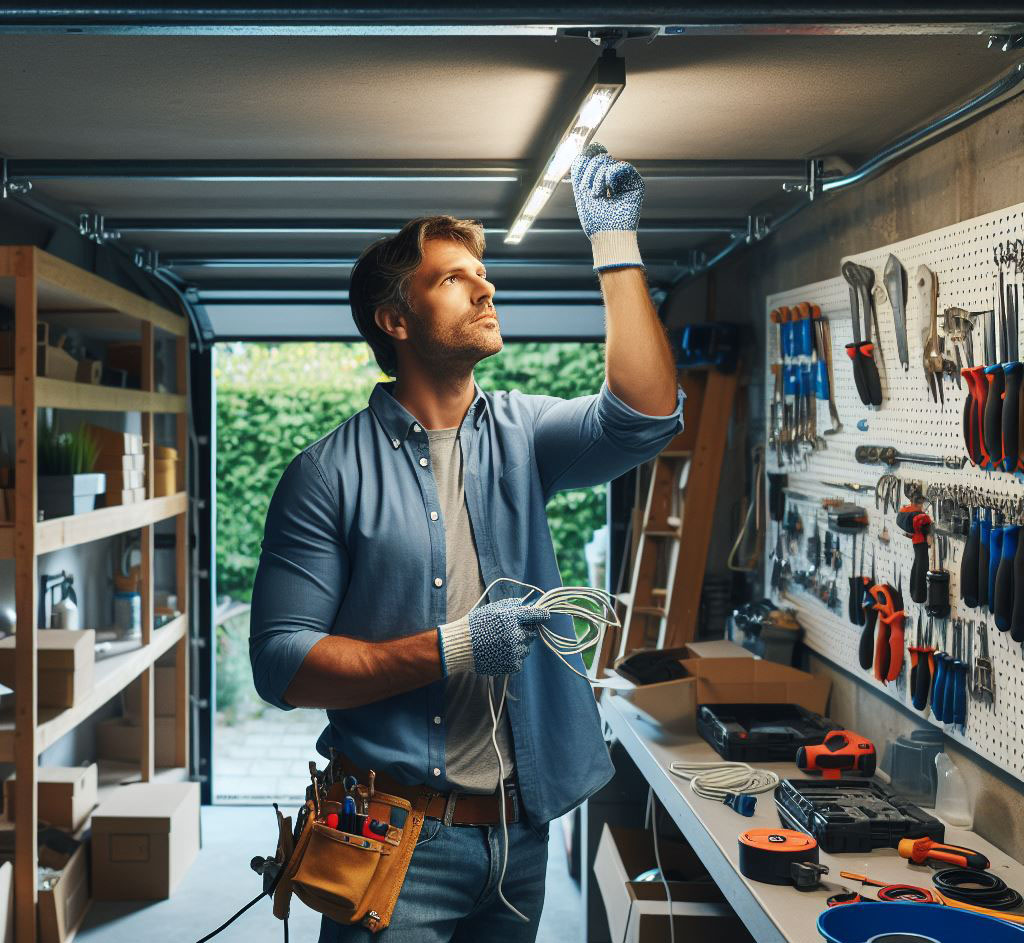In the world of garage tinkering and renovations, lighting isn’t just a matter of screwing in a bulb, it’s a critical tool. Whether you’re overhauling a classic car, building cabinets, or just trying to find your way around, the right lighting can make all the difference. It’s about creating a safe, efficient workspace, where every corner is visible and every shadow banished. Ever tried to work with a poorly lit workbench? It’s like trying to cook a gourmet meal over a candle. A well-lit garage, on the other hand, is a symphony of visibility, safety, and style.

Understanding Garage Lighting Needs
Garages come in all shapes and sizes, and so do their lighting needs. In a residential setup, you’re balancing functionality with aesthetics. You want enough light to work comfortably without turning your garage into a mini football stadium. In a professional setting, it’s a different ball game. Here, precision and flexibility are key. Lighting needs to adapt to various tasks – from detailed work on small components to general maintenance. It’s about choosing the right lumens, not just the brightest bulb in the box.
Types of Garage Lighting
- Ceiling Lights
LEDs are the champions of garage ceiling lighting. They’re energy-efficient, long-lasting, and don’t produce much heat. Fluorescents are a budget-friendly option, but they can be temperamental in cold conditions.
The advantage of LED lighting is akin to the clarity and precision of a high-definition camera compared to the fuzziness of an old VHS tape. Fluorescents might save you some dollars up front, but LEDs are the marathon runners in the race of longevity and energy savings.
- Recessed Lighting
Recessed lighting offers a sleek, unobtrusive option, blending seamlessly with the ceiling. It’s like having a lighting system that’s felt, not seen.
When installing, think like a chess player – strategize the placement to avoid dark corners and uneven lighting. And remember, cutting into your ceiling requires a thoughtful approach. Avoid joists and hidden wiring.
- Task Lighting
Imagine trying to thread a needle in a dim room, that’s what working without task lighting is like. This focused lighting is essential for detailed tasks, whether it’s soldering wires or adjusting carburetors.
Options range from clamp-on lamps, tailor-made for workbenches, to magnetic lights that can be positioned on metal surfaces – invaluable when you’re in the depths of an engine bay.
- Ambient Lighting
Ambient lighting is the foundation of your garage’s atmosphere. It’s not just about brightness, it’s about creating a well-lit, inviting space.
A combination of overhead lights and strategically placed wall fixtures can create layers of light, eliminating harsh contrasts and giving your garage a welcoming feel.
- Modern Lighting Solutions
Today’s garage lighting is smart and adaptable. With features like smartphone control, motion sensors, and adjustable color temperatures, it’s tailor-made for the modern handyman.
Energy efficiency is key. Seek out lights with a high lumens-to-watt ratio. It’s like getting the most horsepower out of the least amount of fuel.
In summary, your garage lighting should be a carefully considered component of your workspace, tailored to your specific needs and activities. It’s not just about making your garage brighter, it’s about making it better. Whether you’re a weekend warrior or a seasoned pro, the right lighting can elevate your garage from a mere storage area to a true workshop haven.

Choosing the Right Lighting
When it comes to lighting your garage, think of yourself as a maestro conducting an orchestra. Each light in your garage plays a crucial role, and it’s your job to ensure they all work in harmony. Let’s break it down:
- Brightness (Lumens)
Lumens are your measure of brightness, like gauging the strength of a cup of coffee. For a typical two-car garage, aim for around 3,500 to 4,000 lumens. It’s like setting the stage for a well-lit workspace where every tool and nut is visible.
- Color Temperature
The color temperature of your lights is measured in Kelvins. Lower Kelvin values give a warm, cozy glow, ideal for a woodshop perhaps, while higher Kelvins offer a daylight-like clarity, perfect for detail-oriented tasks. A range of 4000K to 5000K usually hits the mark for most garages, offering clear visibility without being too harsh.
- Energy Efficiency
LEDs are your go-to for energy efficiency. They’re the compact SUVs of the lighting world: reliable, efficient, and cost-effective in the long run. They might cost a bit more upfront, but they pay off with lower energy bills and longer lifespans.
- Tailoring to Garage Size and Use
Your lighting should match the scale of your garage and the nature of your work. A small, single-car garage used for basic storage might only need basic overhead lighting. But a large workshop with various workstations will benefit from a mix of overhead and task lighting. It’s about customizing your lighting plan to fit your specific needs.

Installation Tips and Safety Considerations
Proper installation is key to ensuring your garage lighting is both effective and safe. Let’s walk through the steps:
- Turn Off the Power
Safety first. Always switch off the power at the main breaker before you begin. It’s the first rule in any electrical work – treat every wire as if it’s live.
- Choose the Right Fixtures
Select fixtures that are appropriate for a garage environment. Look for durability and compatibility with your space. Outdoor-rated fixtures are often a good choice, offering resilience against moisture and temperature changes.
- Positioning is Key
Think like a painter looking at a blank canvas. Position your lights to illuminate the whole space evenly. Overhead lights are your background, while task lights highlight the details – your workbench, tool station, or any other specific area where you need focused light.
- Wiring and Mounting
If you’re comfortable with basic wiring, you can handle simple installations. However, for more complex setups or if you’re unsure, don’t hesitate to call in a professional. Proper mounting is critical – ensure each fixture is securely attached to avoid any potential hazards.
- Safety Checks
Once installed, do a thorough check with the power back on. Look for any signs of trouble like flickering or unusual noises, which can indicate a problem.
- Professional Help for Complex Setups
For high-voltage requirements or intricate lighting systems, enlist the help of a licensed electrician. It’s like bringing in a specialist for a crucial job – it ensures safety and quality work.
By carefully selecting and installing the right lighting, you can transform your garage into a well-lit, efficient, and safe workspace. It enhances not just visibility but also the overall functionality and safety of your workspace. Remember, in the world of DIY, good lighting is as important as any tool in your kit.
Maintenance and Upkeep
Tackling the maintenance of your garage lights is akin to giving your car its regular tune-up. It’s about ensuring they continue to shine bright and function efficiently. Here’s a practical guide:
- Regular Cleaning
Think of dust and grime as the slow creepers that diminish your lights’ efficiency. For most light fixtures, a simple dust-off with a dry, soft cloth is sufficient. If they’re particularly dirty, a light dab with a damp cloth and mild detergent works wonders. Remember, moisture and electricity are not friends, so ensure the cloth isn’t dripping wet.
- Checking Connections
Periodically give your light fixtures and connections a once-over. Loose wires or unstable fixtures can lead to inefficiencies or, worse, hazards. It’s similar to keeping the nuts and bolts on your bike tightened, a little attention can prevent bigger problems down the line.
- Bulb Replacement
Non-LED bulbs will signal their end with flickering, dimming, or a delay in lighting up. Replacing them is usually straightforward. Just ensure the power is off before you start – safety first. It’s like changing a tire, basic, but essential knowledge.
- LEDs and Longevity
LED lights are marathon runners in the lighting world, but even they lose steam over time, dimming gradually. If your LED isn’t as bright as it once was, it’s likely time for a change. Think of it as swapping out a well-used tool that’s seen better days.
FAQ Section
In a compact garage, efficiency and space-saving are key. LED lights are ideal – they’re sleek, energy-efficient, and pack a powerful punch in a small package. Recessed or track lighting can provide ample light without cluttering your workspace. It’s like choosing the right-sized tool for a small job, you want something that fits just right.
Lumens are the measuring stick for light output. For a workshop, aim for about 50 lumens per square foot. So, for a standard two-car garage (around 400 square feet), you’d need about 20,000 lumens. It’s like measuring the right amount of paint for a room – too little and you won’t get full coverage, too much and it’s overkill.
LEDs are often the preferred choice for garages. They’re like the reliable workhorse of lighting – long-lasting, energy-efficient, and available in various color temperatures. The only drawback is the initial cost, but they make up for it with longer life and lower energy bills.
If you’re handy and understand basic electrical safety, installing garage lights is achievable. It’s like tackling any other DIY project – follow the instructions, don’t rush, and ensure the power is off. However, for more complex installations, especially involving new wiring, it’s wise to call in a professional. It’s similar to knowing when to call a plumber – some jobs require expert hands.
Color temperature in lighting sets the mood and functionality of your space. Cooler temperatures (5000K-6500K) resemble daylight and are excellent for tasks requiring attention to detail. Warmer temperatures (2500K-3000K) provide a softer light, creating a more relaxed environment. It’s about matching the light to the work at hand, like picking the right background music for different tasks.
